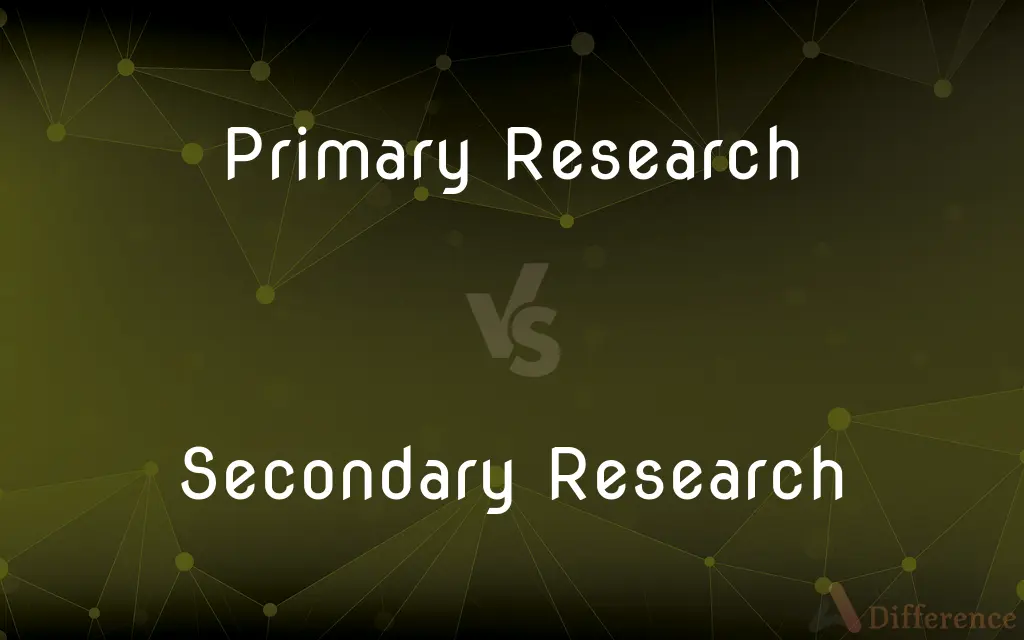Primary Research vs. Secondary Research — What's the Difference?
Edited by Tayyaba Rehman — By Fiza Rafique — Published on December 9, 2023
Primary Research involves collecting new data directly, while Secondary Research uses existing data from prior studies.

Difference Between Primary Research and Secondary Research
Table of Contents
ADVERTISEMENT
Key Differences
Primary Research and Secondary Research are pivotal methodologies in the realm of academic, market, and scientific inquiries. Primary Research entails the direct collection of data tailored to the researcher's unique questions or needs. Through surveys, interviews, or experiments, Primary Research fetches firsthand, original information. Conversely, Secondary Research revolves around the utilization of existing data, gleaning insights from previously conducted studies or published sources.
One might liken Primary Research to a detective conducting interviews to solve a case, capturing fresh testimonies. This method offers the advantage of specificity, allowing research to be molded as per the exact requirements of the investigation. On the other hand, Secondary Research is akin to the detective reviewing old case files. This approach is generally quicker and less costly since it harnesses data already in existence.
While Primary Research can provide more relevant and specific data for a particular query, it's typically more time-consuming and expensive. Gathering new data demands resources, tools, and often a sizable timeframe. Secondary Research, benefiting from the legwork of prior studies, often presents a broader overview and can be accomplished with fewer resources.
However, Primary Research's strength lies in its freshness and direct applicability to the research question at hand. Secondary Research, meanwhile, may sometimes suffer from potential biases of the original researchers, outdatedness, or lack of direct relevance to the current study's specifics.
In essence, Primary Research brings forth novel insights tailored to a study's unique requirements, while Secondary Research offers the advantage of speed and cost-efficiency by using pre-existing data.
ADVERTISEMENT
Comparison Chart
Source of Data
Directly collected by the researcher
Existing data from previous studies or sources
Cost
Typically higher due to data collection efforts
Generally lower as it uses available data
Time Consumption
More time-intensive
Quicker as data is already available
Relevance
Highly specific to the research question
Might not be directly relevant to the current study
Freshness of Data
Newly collected, up-to-date
Could be outdated or influenced by prior study's bias
Compare with Definitions
Primary Research
Original data collection tailored to specific questions.
Sarah conducted Primary Research by surveying customers about their shopping preferences.
Secondary Research
Analysis of existing data from prior studies.
Jane used Secondary Research to understand industry trends by reviewing market reports.
Primary Research
Firsthand investigation for unique insights.
For his thesis, Mike undertook Primary Research, interviewing local artisans.
Secondary Research
Utilization of previously collected information.
His dissertation included Secondary Research from various scholarly articles.
Primary Research
Fresh research efforts for specific inquiries.
Using Primary Research, the team assessed the market's needs through focus groups.
Secondary Research
Harnessing pre-existing data for insights.
The marketing team conducted Secondary Research using online customer reviews.
Primary Research
New data acquisition to answer distinct questions.
Through Primary Research, the NGO gauged community responses to their new initiative.
Secondary Research
Gleaning insights from already available sources.
Secondary Research helped the startup understand competitors through industry publications.
Primary Research
Direct data gathering for novel information.
The company used Primary Research to test its new product's reception.
Secondary Research
Reviewing prior data for broader understanding.
For her project, Emily did Secondary Research by examining census data.
Common Curiosities
Which research type is quicker to conduct?
Secondary Research is generally quicker as it uses available data.
How does Secondary Research differ from Primary Research?
Secondary Research utilizes existing data from prior studies, while Primary Research collects new data.
Is Primary Research always more expensive?
Typically, Primary Research is more costly due to the efforts involved in data collection.
Can Secondary Research be outdated?
Yes, Secondary Research might use older data, making it potentially outdated.
Are there biases in Secondary Research?
Secondary Research might carry biases from the original data sources or studies.
How reliable is Secondary Research?
The reliability of Secondary Research depends on the credibility of the original sources.
What is Primary Research?
Primary Research involves direct data collection tailored to specific research questions.
Is literature review a form of Secondary Research?
Yes, reviewing literature uses existing data, classifying it as Secondary Research.
Why might one opt for Primary Research?
Primary Research offers fresh, specific insights directly relevant to the research question.
Can Primary Research include experiments?
Yes, experiments are a form of Primary Research to gather firsthand data.
Which research type is more specific?
Primary Research is tailored and specific to the researcher's questions.
Can Secondary Research support Primary Research?
Yes, Secondary Research can offer background or context that aids Primary Research.
Do all studies involve Primary Research?
No, many studies rely solely on Secondary Research, especially for broader overviews.
Which research method should I choose?
The choice between Primary Research and Secondary Research depends on your research goals, resources, and desired specificity.
Is fieldwork a part of Primary Research?
Yes, fieldwork involves direct data collection, categorizing it as Primary Research.
Share Your Discovery

Previous Comparison
Cost of Equity vs. Cost of Retained Earnings
Next Comparison
NPV vs. PaybackAuthor Spotlight
Written by
Fiza RafiqueFiza Rafique is a skilled content writer at AskDifference.com, where she meticulously refines and enhances written pieces. Drawing from her vast editorial expertise, Fiza ensures clarity, accuracy, and precision in every article. Passionate about language, she continually seeks to elevate the quality of content for readers worldwide.
Edited by
Tayyaba RehmanTayyaba Rehman is a distinguished writer, currently serving as a primary contributor to askdifference.com. As a researcher in semantics and etymology, Tayyaba's passion for the complexity of languages and their distinctions has found a perfect home on the platform. Tayyaba delves into the intricacies of language, distinguishing between commonly confused words and phrases, thereby providing clarity for readers worldwide.
















































